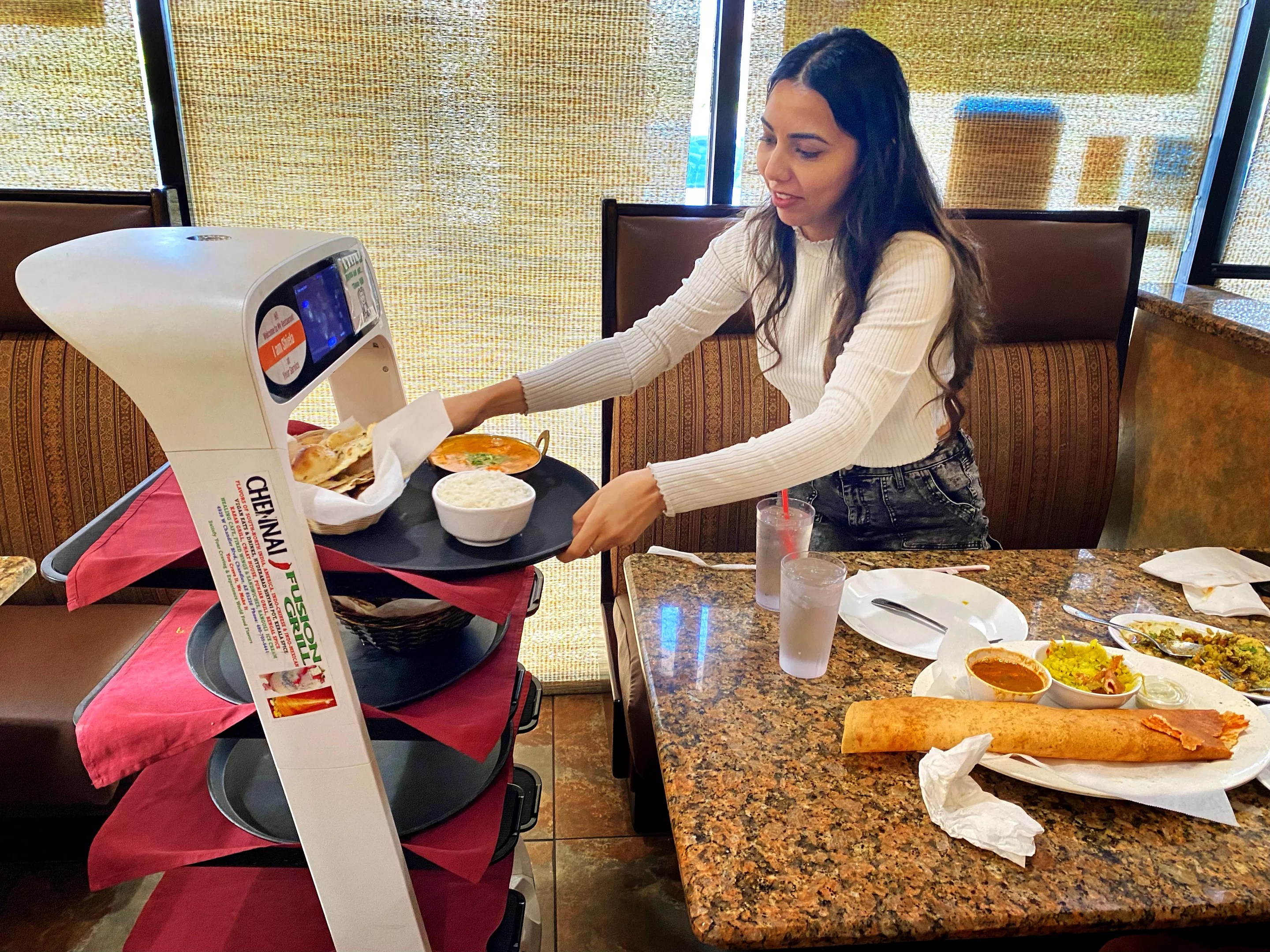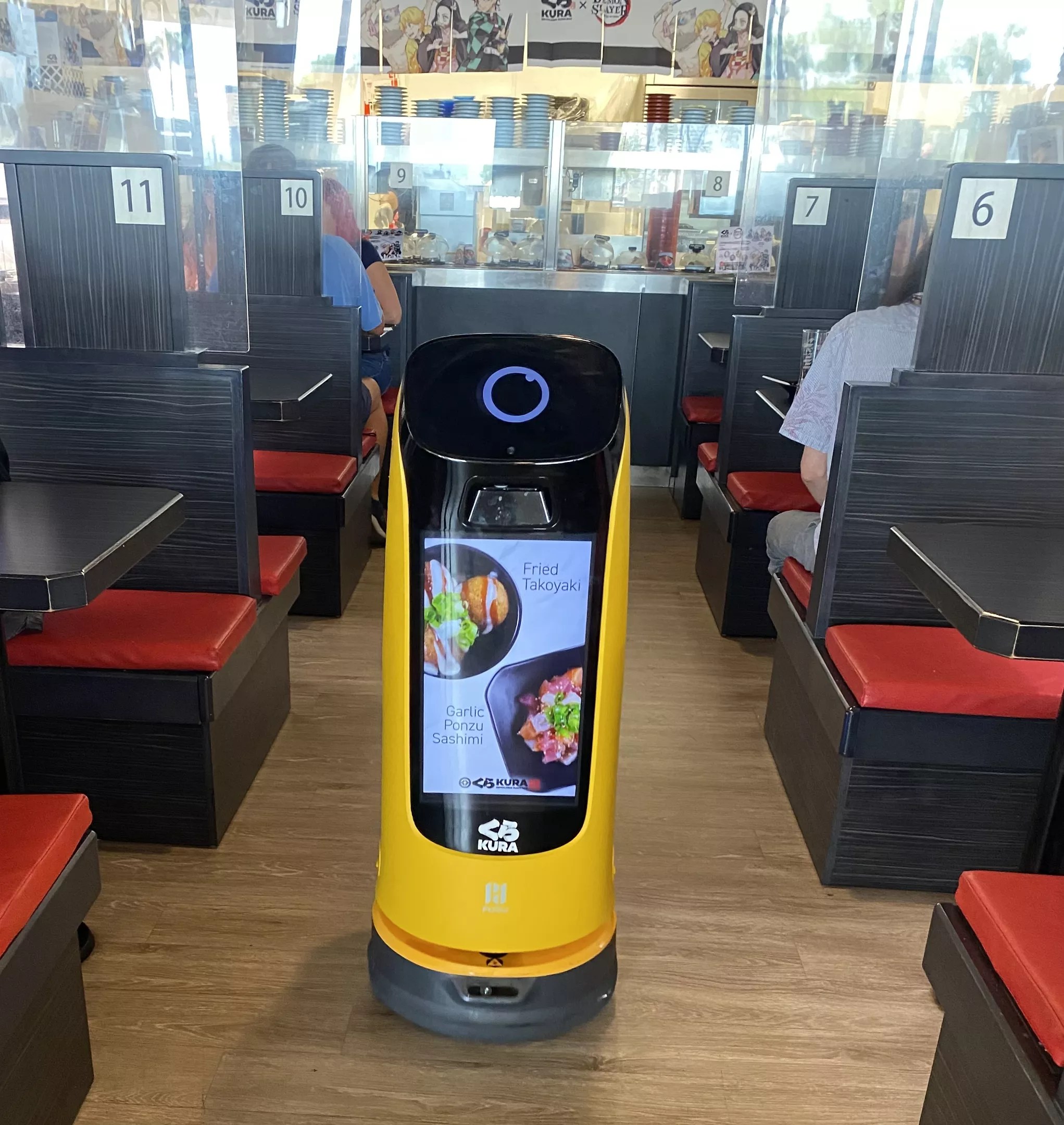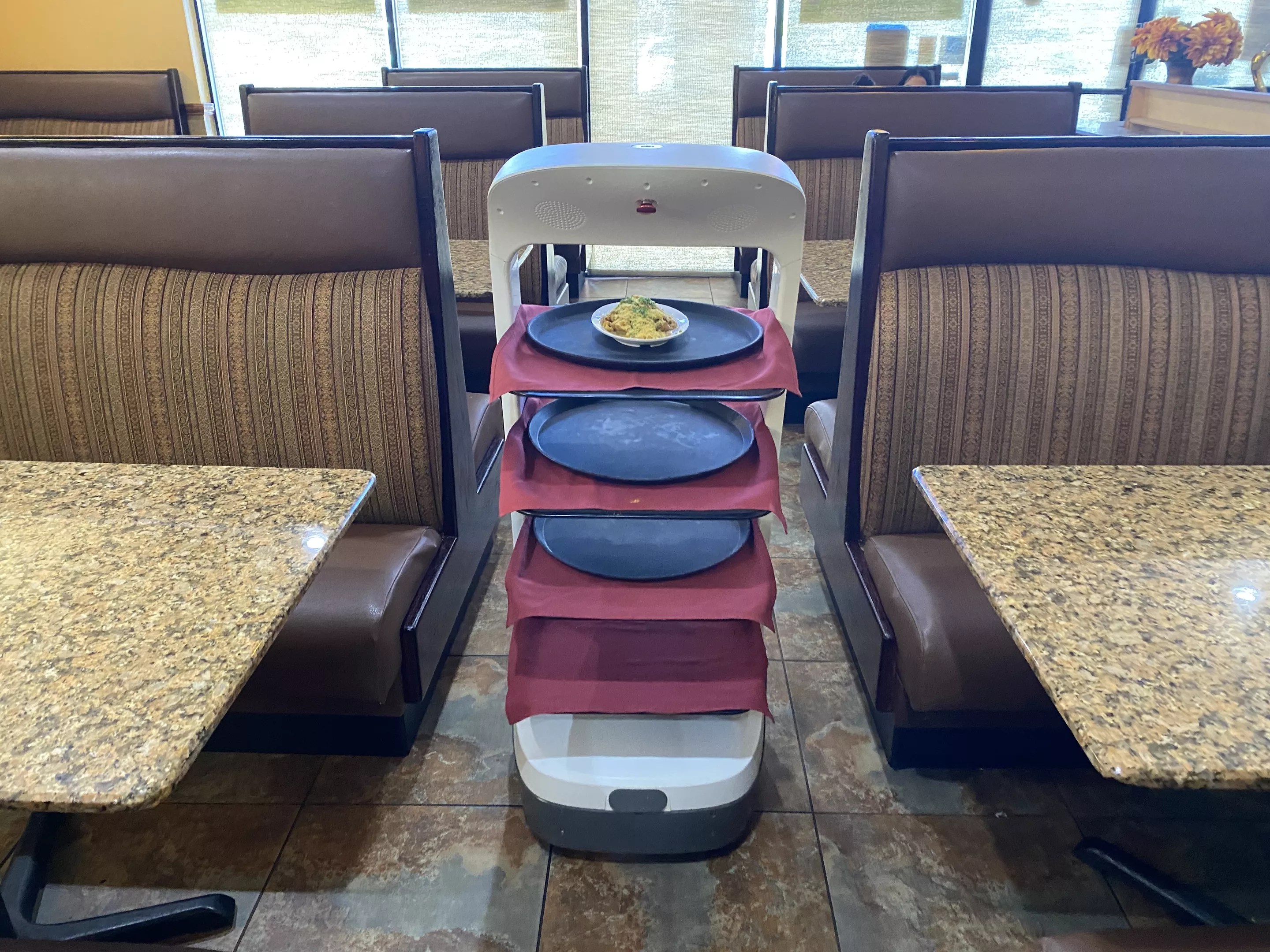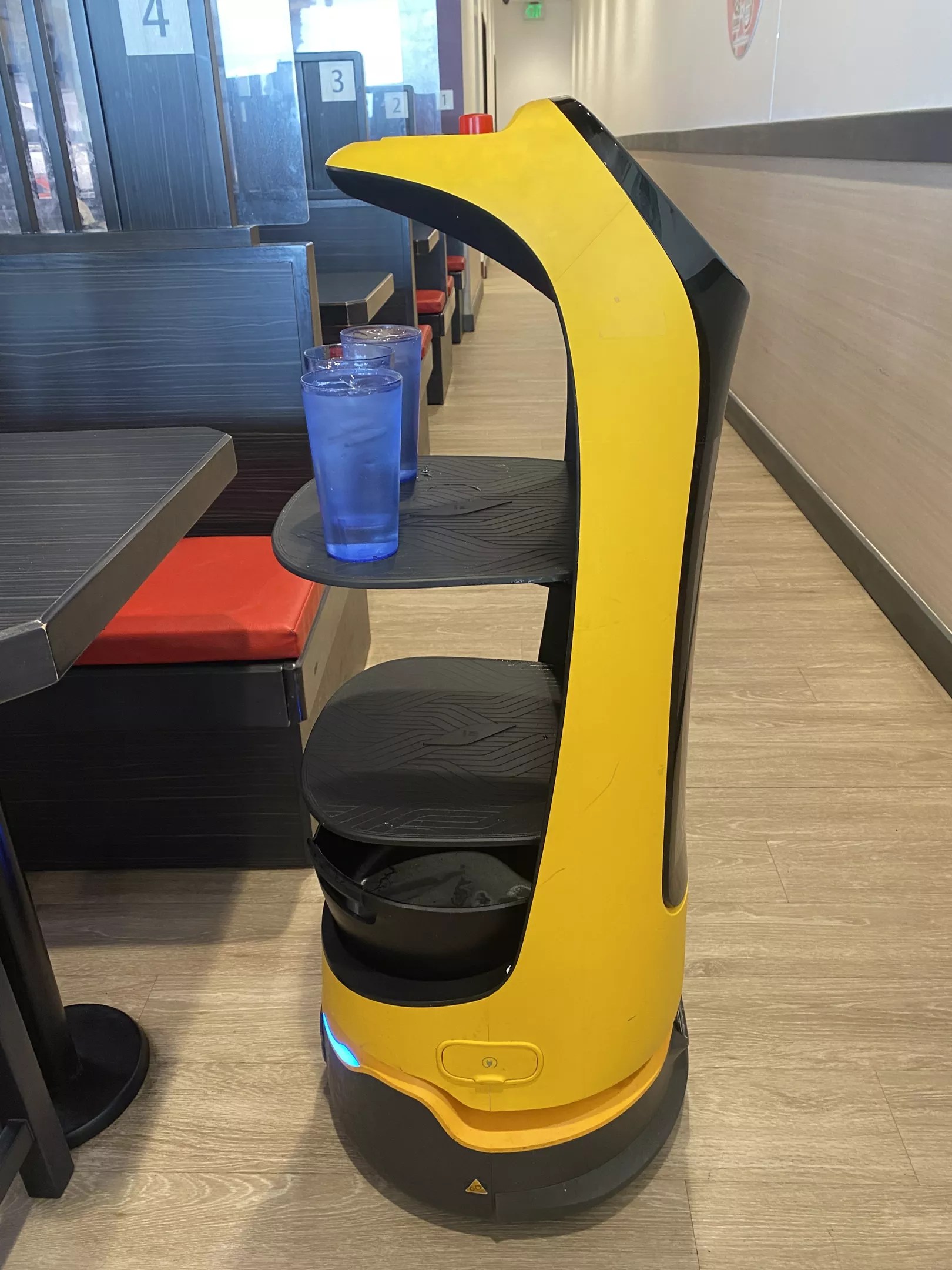
Geri Koeppel

Audio By Carbonatix
Anyone who owns a restaurant, works at a restaurant, or has eaten at a restaurant in the past couple of years knows that the industry has a major labor shortage.
Now, robots with tiers of trays that deliver food and drinks are starting to fill the gap. The cute, talking, rolling automated servers assist with marketing as well, in mass media, social media, and even old-fashioned word-of-mouth.
From dim sum spots in New York City using robots with kitty faces to Chili’s enlisting “Rita” the robot in more than 50 stores nationwide, including Bullhead City, Lake Havasu, and Kingman, the trend is picking up steam.
Robots use light-detecting radar or LIDAR to navigate tables and avoid obstacles, rarely making an error and never calling in sick. They can be found here in the Valley at Kura Sushi, a revolving grab-your-own-roll chain out of Japan with locations in Chandler and Phoenix, and Chennai Fusion Grill, an independent Indian restaurant in Chandler.
This year, make your gift count –
Invest in local news that matters.
Our work is funded by readers like you who make voluntary gifts because they value our work and want to see it continue. Make a contribution today to help us reach our $30,000 goal!
Kura Sushi’s robots, named “Kur-B” speak, play sing-song music and deliver water and soft drinks. They are a talking point for customers, some of whom come specifically to see them, according to Chandler manager Christy Nguyen.
“They video the robots. They take pictures with the robots. They talk to them, saying, ‘thank you,’ saying ‘hi,'” she says. “And the children that come in with their parents, they get very excited over the robots.”

Kur-B robots at Kura Sushi display pictures of the food on the front and deliver water and soft drinks from trays on the back.
Geri Koeppel
The company began researching robots prior to the pandemic as part of its culture of implementing new technology and providing “eatertainment” to guests, says Hideto Sugimoto, director of system and menu development for Kura Sushi USA.
The chain introduced the robots, which are manufactured by Pudu Robotics in China, this summer in its 37 U.S. locations.
Hajime “Jimmy” Uba, the CEO of Kura Sushi, also said in Restaurant Dive, an industry publication, that robots have helped keep staffing levels at about 95 percent.
“They help us a lot to focus on customer interactions,” Nguyen said of the robots. “It gives the servers more of a chance to talk to the guests.”
Or just the opposite. A couple of Gen-Z customers admitted that not having to interact with another human was a plus. They dislike having to flag down servers, wait for them, and have them hover over them interrupting their meal. The robots deliver quickly and don’t stand around trying to chit-chat.
On a similar note, the owner of Chennai bought a robot named “Shiela” about a year ago to reduce face time in order to help prevent the spread of COVID-19, manager Nick Kanyal says.

Robot servers like “Shiela” use LIDAR to find their way to tables.
Geri Koeppel
Shiela delivers plates of samosas, curry, and dosa, and, like Kur-B, the squat, chirpy machine became an attraction.
“Lots of customers, they tell us they came to see the Shiela,” Kanyal says.
As it arrives at a table, Shiela says, “Your meal is ready. Please take it away!” And it can even be a little sassy. If someone blocks its way, it might say, “Don’t be obsessed with me too much. I’m busy now.”
The robots have become rock stars on social media. Sim Kaur of Buckeye says she drove all the way to Chandler to meet Shiela after seeing it on TikTok. Kristina Sky of Phoenix says she initially spied Kur-B at Kura Sushi on TikTok as well, and after seeing it for the first time in person, says it was “the coolest frickin’ thing ever.”
Sugimoto says when they first rolled out Kur-B in an announcement on social media in June, the post became their most popular ever.
“The engagement and positivity was truly overwhelming,” Sugimoto says.
Niccolo Iannello of Phoenix, who’s been to Kura Sushi “more than 10 times,” has taken people to show them the robots.
“The first time I went, I did not know about it, and it was a very cool and fun surprise,” he says.
Several companies manufacture robots, including Delta Technology in Tempe, which designs, builds, engineers, and employs automation solutions. Though the company hasn’t sold any robot servers yet, Paul A. Soucek, the company’s director of marketing and new product development, says it’s in the works.
“We have a tremendous amount of interest in it, and we do have proposals out,” he says.
Though robots are still a marketing tool “to a certain extent,” according to Soucek, he thinks there will be a “quantum shift” toward automated mobile robots as restaurants continue to have trouble finding people to do menial tasks.
“These are positions that, in all honesty, people don’t want to do,” Soucek says.
That was the case for Skyler Reeves, owner of The County Seat in Prescott, who bought an automated server in July to solve staffing issues. However, he emphasized he wasn’t replacing humans.
“We’re using robots to do robotic tasks, which hopefully will make the customer service better,” Reeves says.

Kur-B (short for Kura Bot) robots were rolled out in June at all U.S. locations of Kura Sushi, including Chandler (shown) and Phoenix.
Geri Koeppel
Soucek declined to say how much automated servers cost, but Reeves says based on his research, they generally run $15,000 to $22,000.
“We did the math on purchasing it, and that made it a pretty easy decision,” Reeves says.
Soucek did say Delta Technologies’ customers are looking for a return on investment of about 12 to 24 months. As any new technology becomes more widespread, the cost goes down, he says.
“I think we’re going to see that same type of progression in the restaurant industry,” he says.
Robots might help restaurants with labor and improve service for patrons, even if the marketing value fades as the novelty dies down. But do they help or hinder human servers when it comes to earning tips?
Sugimoto said robots allow staff at Kura Sushi to cover more tables than the industry norm, typically eight to 10 at a time, which naturally translates into more tips.
On the other hand, Kanyal, at Chennai, says it hasn’t made much of a difference, adding, “Some people [joke] they’ll tip the robot.”